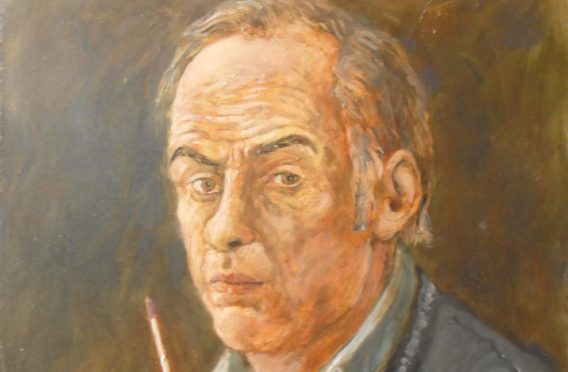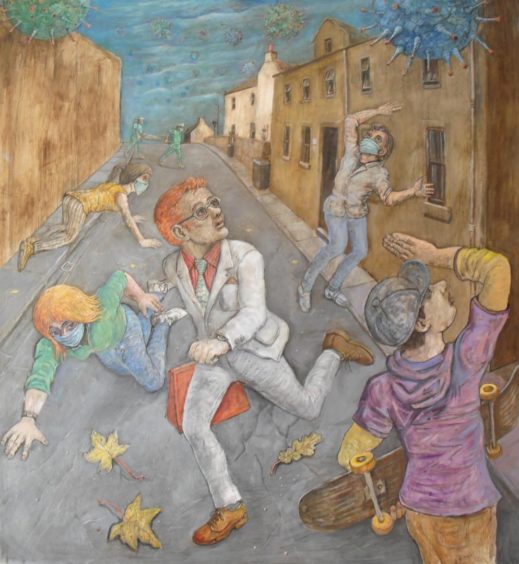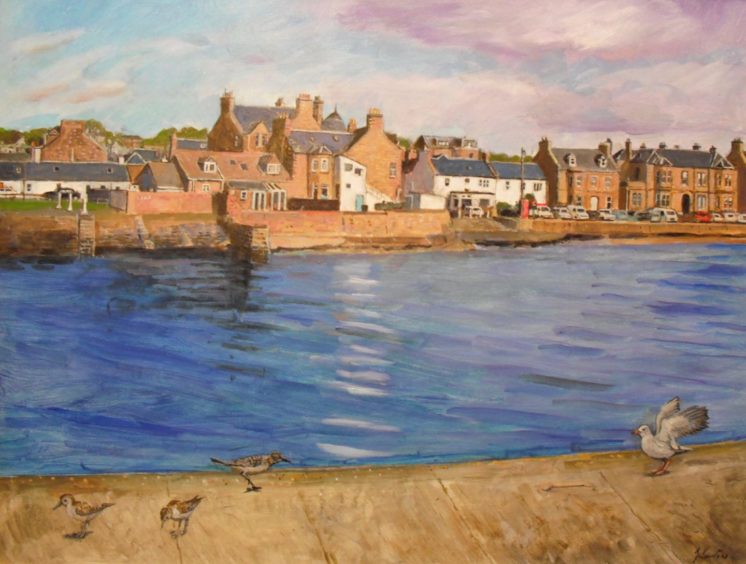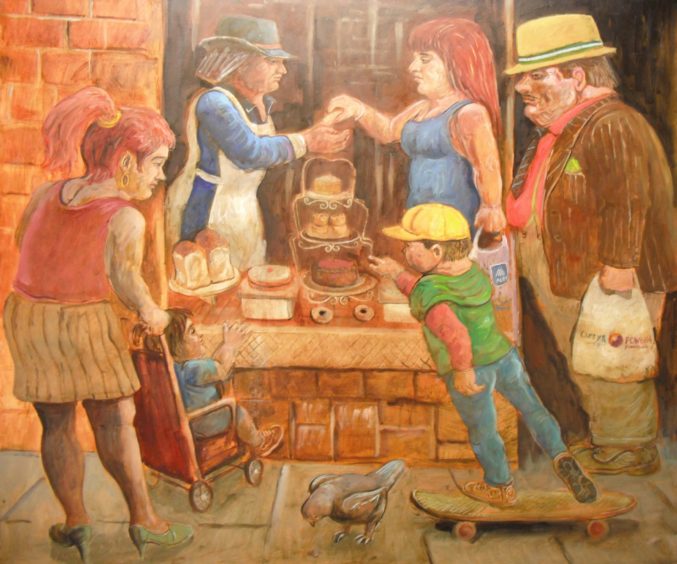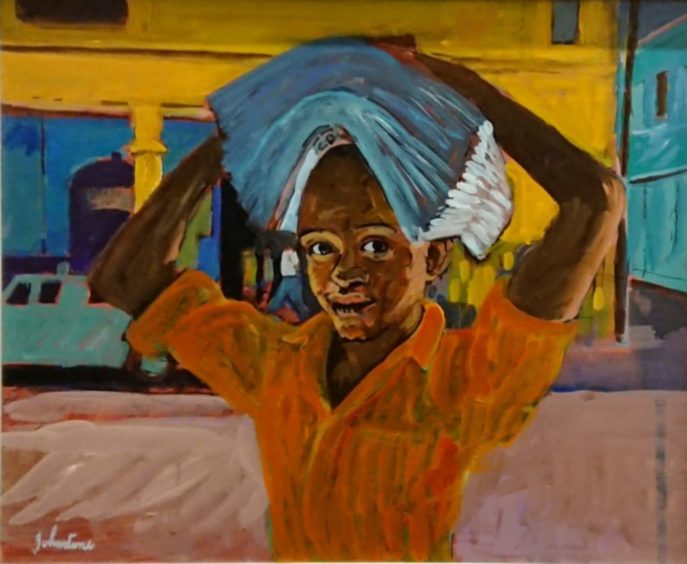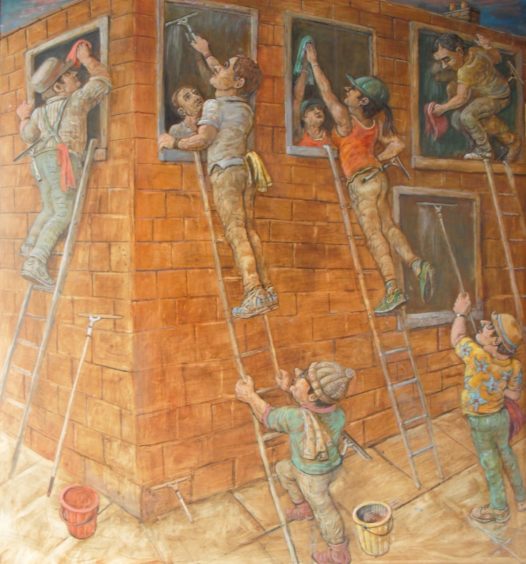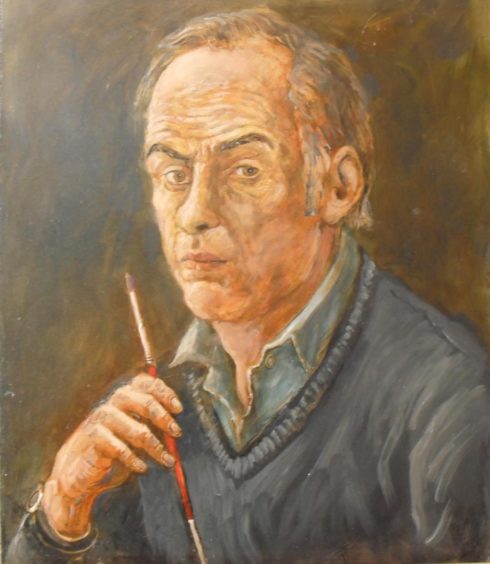He is one of Scotland’s leading artists with an instantly recognisable figurative style that’s captured Dundee scenes including ‘At the Morgan’ and ‘Boy and Bike, Man and Bird, city centre (Dundee)’.
Now, as 60 years of painting is celebrated with an exhibition of John Johnstone’s latest work at the city’s Gallery Q, he also captures the times in which we live with a contemporary piece called ‘Coronavirus comes to town’.
John Johnstone – a lifetime of art
Born in Forfar in 1941, as a child John was always drawing and, with his two elder brothers, would copy cartoons of footballers.
He was interested in how the human body worked and was particularly influenced by the illustrative work of Dudley D Watkins, who is better known for his famous comic strips for Courier publishers D C Thomson & Co Ltd.
At 13 John was sent to Edinburgh Academy boarding school, an event which he found traumatic as an artistic rather than academic child.
His sanctuary was the art room and the remarkable art master John Frith who took him under his wing and nurtured his artistic ability.
After school, John attended Duncan of Jordanstone College of Art in Dundee from 1959 to 1964 and studied under David McClure and Alberto Morrocco.
He experimented with different styles of painting under their tutelage and found his own vigorous, direct expressionist style.
His early work was influenced heavily by the work of artists such as Soutine and Kokoschka.
When John combined these influences with his fascination for the human figure, a distinctive and powerful style emerged.
This work was concerned with death, social injustice and inhumanity in complete contrast to the fashionable styles encouraged at the time.
Scholarship
He won a travel scholarship and spent six months visiting galleries across Europe and had two exhibitions in a gallery in London’s Mayfair in 1966 and 1967.
His first show at the Alwin Gallery in Mayfair in 1966 contained work from his Post-Dip show, “full of anguish, suffering and a desperate acceptance of the absurd”, wrote Conroy Maddox the English surrealist artist in the Art Review.
His second show, again at the Alwin Gallery, a year later, drew the attention of the London based writer for the The Scotsman, Robert Macdonald, who wrote: “The paintings in his first show had a nightmarish violence about them that was disturbing, but the expressionism is now becoming more coherent and controlled and his work is gaining painterly qualities which make it evident that he is an artist to be watched.
He then spent six months in Jamaica with his close friend, supporter, and fellow Duncan of Jordanstone graduate, Judy Ann Macmillan, now a preeminent artist in Jamaica.
She organised John’s first solo exhibition of his career, in Kingston.
On his return from Jamaica John was uncertain of his next steps. After a promising part of his career John seemed to lose his way. In a letter he wrote “My seven years as an angry young man are over.” – he found it increasingly difficult to paint in this disturbing, expressionistic style.
However, a retrospective exhibition at the Tate of work by Edward Burra proved revelatory and provided John with the inspiration to forge forward with his painting once again.
Change of direction
Now more controlled and less expressionistic, John’s work became more illustrative allowing him to add more detail to his work.
He spent six months in Liverpool with friend and artist Joe McIntyre, sketching the city during the day and selling household goods door to door in the evenings.
Back in Scotland he returned to Duncan of Jordanstone to teach part-time life classes, passing on his knowledge to a new generation of artists who have gone on to forge their own careers such as Joseph Urie, Ian Hughes and Michael McVeigh.
He settled back in Forfar and abandoned his previous expressionist style in favour of the more detailed, illustrative one that we are so familiar with today.
In the mid-1970s, John discovered etching when a printmakers’ workshop was set up in Dundee, managed by his friend Donald McKenzie.
John took to the technique and added to their appeal by hand-colouring them with watercolours.
Joe McIntyre has said: “Etching was a very natural thing for John because of his line drawing, also his sense of composition and his wonderful imagination.”
John’s narrative style has continued to develop, he has introduced much humour as well as satirising topics of the day.
His subject matter is wide ranging and includes many local scenes as well as those taken from literature such as Alice in Wonderland.
Throughout his work he introduces famous characters who just happen to be walking down his Dundee streets, especially Bob Dylan, who is one of John’s obsessions.
John says of his work: “My paintings seem to be expressing something, either serious or amusing about life. They depict people acting out minor dramas. Gesture, composition, characterisation and setting are important. There is an element of gravity in them, but the humorous side probably eclipses that aspect.”
Art classes
John continues to teach art classes in Dundee and Fife.
He has works in public and private collections at home and abroad including Carnegie Trust’s Art Collection, Angus Council Collection, Dundee City Collection, The McManus Galleries Collection and Fife Council Museums West Collection.
John Johnstone: celebrating 60 years of painting, runs at Gallery Q, Nethergate, Dundee, from May 22 to June 19, 2021.
